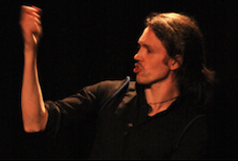 Sagnfuglen Føniks går under mange navn. I Egypt heter den Bennu. I de persiske områdene går den under navnet Simurgh.
Sagnfuglen Føniks går under mange navn. I Egypt heter den Bennu. I de persiske områdene går den under navnet Simurgh.
Fellestrekkene er gjerne fjærene av rødt gull, tårene som kan lindre all smerte og det faktum at den brenner opp hvert femhundrede år for så å gjenfødes. I 2009 lagde jeg forestillingen Chasing the Phoenix i sammenheng med Dante-teateret «Immigrant Reading of a Comedy».
Handlingen er en mytisk og underlig reise gjennom tid, rom og drømmeaktige lag, alltid med en rød fjær i utkanten av synsranden. Føniksen er et symbol på forandring, en endring gjennom krise (opprinnelig gresk betydning: vendepunkt) og renselse gjennom kjærlighetens flammer.
Vår verden er en fugl av ild. Og under Athens Fortellerfestival til helgen kommer jeg til å fortelle historien på ny.
Forestillingen er støttet av UD (Stikk) og Den norske ambassaden i Hellas.
Se forøvrig hva ambassaden skriver her. (Chasing the Phoenix er ikke akkurat et norsk folkeeventyr, men, men. :)) The legendary firebird has many names. In Egypt it’s called Bennu. In the old Persian country it’s known as Simurgh. The common denomination of this legendary bird often boil down to the feathers, seemingly made of red gold, it’s tears, able to heal all pain, and the final fact that it immolates every few centuries or so as the final stage before it’s resurrection. In 2009 I made the performance Chasing the Phoenix as part of the 24 hour Dante theatre «Immigrant Reading of a Comedy» in Trondheim, Norway. The narrative concerns a mythical and perplexing journey through time, space and dream, always chasing a red feather, constantly out of reach. The Phoenix is a symbol of change, a change through crisis (original Greek meaning: «turning point») and purification through the flames of love. Our world is a bird of fire. And during the Storytelling festival in Athens this weekend I will tell the tale anew.
The legendary firebird has many names. In Egypt it’s called Bennu. In the old Persian country it’s known as Simurgh. The common denomination of this legendary bird often boil down to the feathers, seemingly made of red gold, it’s tears, able to heal all pain, and the final fact that it immolates every few centuries or so as the final stage before it’s resurrection. In 2009 I made the performance Chasing the Phoenix as part of the 24 hour Dante theatre «Immigrant Reading of a Comedy» in Trondheim, Norway. The narrative concerns a mythical and perplexing journey through time, space and dream, always chasing a red feather, constantly out of reach. The Phoenix is a symbol of change, a change through crisis (original Greek meaning: «turning point») and purification through the flames of love. Our world is a bird of fire. And during the Storytelling festival in Athens this weekend I will tell the tale anew.
The performance is kindly supported by the Norwegian Foreign Ministry and the Norwegian Embassy in Greece.
The embassy has made a small text about my performance. (It’s not exactly a Norwegian folk tale, though. :))


Legg igjen en kommentar